 W
WAgriochoerus is an extinct genus of scansorial herbivore of the tylopod family Agriochoeridae, endemic to North America. Agriochoerus and other agriochoerids possessed claws, which is rare within Artiodactyla, as well as likely being scansorial. Agriochoerus was first described in 1869.
 W
WAnthracotherium was a genus of extinct artiodactyl ungulate mammals, characterized by having 44 teeth, with five semi-crescentic cusps on the crowns of the upper molars. The genus ranged from the middle Eocene period until the early Miocene, having a distribution throughout Eurasia. Material subjectively assigned to Anthracotherium from Pakistan suggests the last species died out soon after the start of the Miocene.
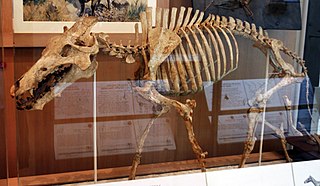 W
WArchaeotherium is an extinct genus of entelodont artiodactyl endemic to North America during the Eocene and Oligocene epochs (35—28 mya), existing for approximately 9.1 million years. Archaeotherium fossils are most common in the White River Formation of the Great Plains, but it has also been found in the John Day Basin of Oregon and the Trans-Pecos area of Texas.
 W
WBothriogenys was a genus of anthracotheres that lived in Eastern Africa during the late Eocene to early Oligocene. Most fossils have been found in Fayum, Egypt, but one species, B. orientalis, is known from late Eocene deposits in Thailand.
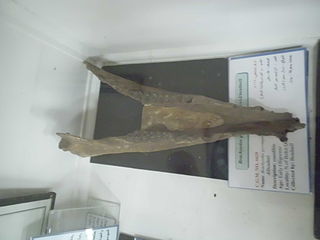 W
WBrachyodus was a genus of anthracothere that lived in Europe during the Early Miocene.
 W
WCainotherium is an extinct genus of rabbit-sized prehistoric even-toed ungulates. These herbivores lived in Europe from the Eocene until the early Miocene. The skeletal anatomy of these hare-like animals suggest they, along with other members of Cainotheriidae, belong to the artiodactyl suborder Tylopoda, together with oreodonts and modern camelids. Species had cloven hooves, similar to those of bovids or deer, although the shape and length of the limbs suggests that the living animals moved by leaping, like a rabbit. The shape of the teeth also suggests a rabbit-like diet of nibbled vegetation, while the size of the auditory bulla and shape of the brain suggest that it would have had good senses of hearing and smell.
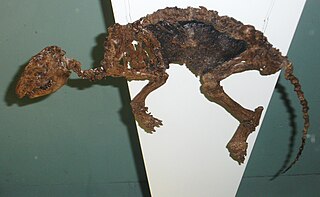 W
WDichobunidae is an extinct family of basal artiodactyl mammals from the early Eocene to late Oligocene of North America, Europe, and Asia. The Dichobunidae include some of the earliest known artiodactyls, such as Diacodexis.
 W
WElomeryx is an extinct genus of artiodactyl ungulate, and is among the earliest known anthracotheres. The genus was extremely widespread, first being found in Asia in the middle Eocene, in Europe during the latest Eocene, and having spread to North America by the early Oligocene.
 W
WEntelodon, is an extinct genus of entelodont artiodactyl endemic to Eurasia. Fossils of species are found in Paleogene strata ranging in age from the Houldjinian until the Rupelian epoch of the early Oligocene.
 W
WEporeodon is an extinct genus of oreodont belonging to the family Merycoidontidae. It lived from the Oligocene epoch 30.8—24.8 mya) existing for approximately 6 million years.
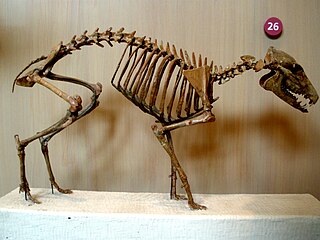 W
WHypertragulidae is an extinct family of artiodactyl ungulates that lived in North America, Europe, and Asia from the Eocene until the Miocene, living 46.2—13.6 million years ago, existing for about 33 million years.
 W
WHypisodus is an extinct genus belonging to the family Hypertragulidae, within the order Artiodactyla, endemic to North America during the Eocene through Oligocene, living 37.2–26.3 Ma, existing for approximately 10.9 million years.
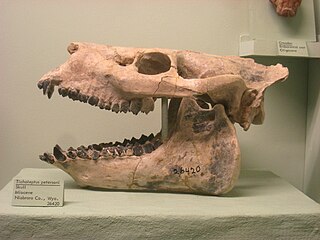 W
WHypsiops is an extinct genus of oreodont of the family Merycoidodontidae endemic to North America. They lived during the Late Oligocene to Early Miocene epochs, 20.4—16.0 mya, existing for approximately 4 million years. Fossils have been uncovered throughout the western U.S. in Oregon, Montana, Wyoming, and Nebraska.
 W
WLeptauchenia is an extinct goat-like genus of terrestrial herbivore belonging to the oreodont family Merycoidodontidae, and the type genus of the tribe Leptaucheniini. The genus was endemic to North America during the Late Oligocene to Early Miocene and lived for approximately 17.6 million years.
 W
WLeptaucheniinae was a taxon of small, goat-like oreodonts with proportionally big heads found throughout North America during the Late Oligocene. Because skeletons of Leptauchenia and Sespia have been found by the literal thousands, they are often quoted as being the most numerous fossil mammals in North America during the Late Oligocene. They had high-crowned, hypsodont teeth which were used to chew gritty vegetation.
 W
WLeptomerycinae is an extinct subfamily within the ruminant family Leptomerycidae. It contains three genera, Leptomeryx, Pronodens, and Pseudoparablastomeryx, which lived in North America during the Middle Eocene to Middle Miocene. Leptomeryx may also have occurred in Asia during the Early Oligocene. Leptomerycies were primitive and ancient ruminants, resembling small deer or musk deer, although they were more closely related to modern chevrotains.
 W
WLeptomeryx is an extinct genus of ruminant of the family Leptomerycidae, endemic to North America during the Eocene through Oligocene 38–24.8 Mya, existing for approximately 13.2 million years. It was a small deer-like ruminant with somewhat slender body.
 W
WMerycochoerus is an extinct genus of oreodont of the family Merycoidodontidae, endemic to North America. They lived during the Early Oligocene 33.9—30.8 mya, existing for approximately 3 million years. Fossils are widespread through the western United States.
 W
WMerycoides is an extinct genus of oreodont of the subfamily Merycoidodontinae endemic to North America. It lived during the Oligocene to Late Miocene, 30.8—16.0 mya, existing for approximately 15 million years. Fossils have been uncovered throughout the western U.S. as well as Florida.
 W
WMerycoidodon is an extinct genus of herbivorous artiodactyl of the family Merycoidodontidae, more popularly known by the name Oreodon. It was endemic to North America during the Middle Eocene to Middle Miocene existing for approximately 30 million years.
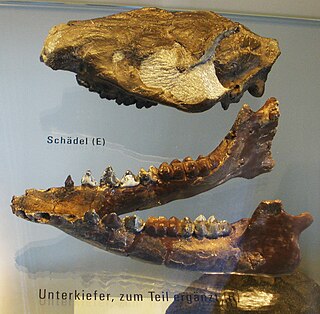 W
WMicrobunodon was a genus of extinct artiodactyl mammals in the family Anthracotheriidae. It lived between the upper Eocene and the lower Pliocene. Its fossil remains have been found in Europe and Asia.
 W
WMiniochoerus is an extinct genus of small oreodont endemic to North America. They lived during the Late Eocene to Early Oligocene 38–30.8 mya, existing for approximately 7 million years. Fossils have been found only in North Dakota, South Dakota, Nebraska, Montana, and Wyoming.
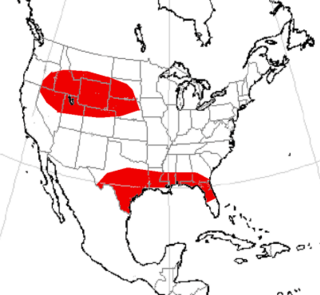 W
WNanotragulus is an extinct genus of hypertragulid ruminant found in North America, Europe, and Asia. It lived from the Middle Eocene to the Early Miocene, living 46.2–20.4 Ma, existing for approximately 26 million years. Fossils have been found from Oregon and Montana to Florida.
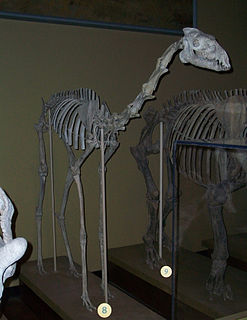 W
WOxydactylus is an extinct genus of camelid endemic to North America. It lived from the Late Oligocene to the Middle Miocene, existing for approximately 14 million years. The name is from the Ancient Greek οξύς and δάκτυλος.
 W
WParaentelodon is an extinct entelodont from the Late Oligocene and Oligocene-Miocene boundary of Asia. The fossils of the type species P. intermedium were found in Georgia, Kazakhstan and China. An indeterminate species represents in Bugti Hills which is the late Oligocene of Pakistan.
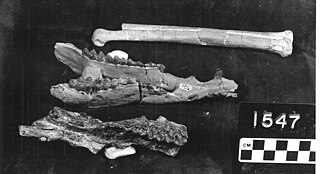 W
WParatylopus is an extinct genus of camelid, endemic to North America. It lived from the Oligocene to the Middle Miocene 33.9—16.0 Mya, existing for approximately 18 million years. Fossils have been found in western Wyoming, and from eastern Nebraska to northeastern Colorado and southwestern South Dakota.
 W
WPhenacocoelus is an extinct genus of oreodont of the family Merycoidodontidae, endemic to North America. They lived during the Early Miocene 24.8—20.4 mya, existing for approximately 4 million years. Fossils have been uncovered in eastern Wyoming and western Nebraska.
 W
WPoebrotherium is an extinct genus of camelid, endemic to North America. They lived from the Eocene to Miocene epochs, 46.3—13.6 mya, existing for approximately 32 million years.
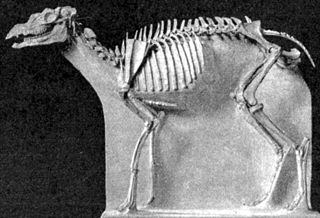 W
WProtoceras is an extinct genus of Artiodactyla, of the family Protoceratidae, endemic to North America. It lived from the Oligocene to the Early Miocene 33.3—16.0 Ma, existing for approximately 17 million years.
 W
WSespia is an extinct genus of oreodont endemic to North America. They lived during the Late Oligocene 26.3—24.8 mya, existing for approximately 1.5 million years. Sespia was cat to goat-sized and desert-dwelling. The genus was closely related to the larger Leptauchenia.